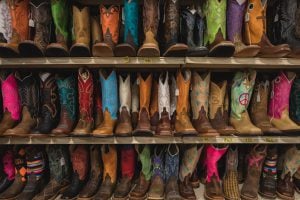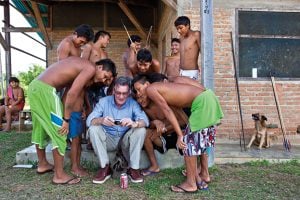
Travel
Eight things to see, eat, drink and do in the Texas Panhandle
From the canyonlands to the rodeo culture, the thriving arts scene to the small but distinguished wine region, the Texas Panhandle is full of surprises
- 935 words
- 4 minutes
This article is over 5 years old and may contain outdated information.
Travel

There are places you fall in love with at first sight and yearn to see again. Arizona is such a place for me. Twenty years after my first visit, I still dream about hiking the canyon trails, breathing the crisp air and embracing the silence. Last spring, I had a chance to return to the desert state, but only for one week. By chance, my trip began on April Fool’s Day and spanned the Christian Holy Week. Taking the timing as a blessing rather than a hoax, I set out to revisit my dreamscapes in fast-forward, eager to play tourist, explorer and pilgrim all at once.

Day 1: Sedona Driving from Phoenix to Sedona, once you exit the interstate onto Highway 179, it takes only a few minutes to see why this area is called Red Rock Country. Ancient sandstone formations take over the landscape, the Mogollon Rim’s dramatic escarpment a backdrop of orange and pink against cerulean blue skies. The chromatic vibration is spectacular.
It’s easy to be enchanted by this part of Arizona — and exploring it is even easier. There are trailheads everywhere, even on residential backstreets. Once, in the middle of West Sedona’s sprawl, I found a fabulous trail to iconic Coffee Pot Rock; the hike originated from behind a supermarket.
I meet an old friend at Airport Mesa, which is the site of the city’s airport as well as a famous lookout for watching sunsets. The spot is such a magnet for visitors, however, I can’t find a place to park. So we give up and head to the Mesa Grill, where our server explains that Airport Mesa is situated at a popular “vortex,” a swirling centre of energy funnelling from the Earth. There may not be much science behind this belief, but it seems like good business in Sedona, considering the abundant advertising for crystal healing, soul recovery and channelling. This spiritual Disneyland has been a hub for New Agers since the 1990s and an escape for Hollywood stars since the 1920s, but it has drawn seekers to this region for a lot longer: the Hohokam, Sinagua and other tribes have occupied central Arizona for centuries.
Day 2: Loy Canyon, Red Rock Country After a bumpy ride on dusty back roads, Pink Jeep Tours guide Kevin Sandlin stands at the trailhead of the Honanki Heritage Site, one of the best preserved cliff dwellings in the Verde Valley. The Sinagua lived here from about 1100 to 1300, Sandlin says. “These ruins are a sacred place to many tribes,” he adds, “particularly the Hopi, who believe they are direct descendants of the Sinagua people.” The cliff dwellings’ mesmerizing masonry walls — hard to see at first because they blend into the rose-coloured surroundings — follow the contour of the canyon and are covered with rock art. This awe-inspiring site is believed to once have had three storeys of homes and one of the largest populations in the area.

As I climb a narrow path lined with prickly pear cacti and try to shoot some video, I catch myself thinking that I should be admiring the scenery instead of trying to capture it on my memory card. Seconds later, I trip and fall on my camera. It’s now covered with red powder and the shutter appears to be stuck. “Pay attention,” I admonish myself. “Show a little respect.” The camera still works but shoots cock-eyed frames.
We come to a giant alligator juniper tree which may be as old as the ruins. These trees can live for up to 1,200 years, Sandlin says, and this one could be half that. I touch the rugged bark and make a healing wish. I remember this particular juniper tree from 20 years ago.
After hiking the Boynton Canyon scenic trail and stopping for lunch at the Enchantment Resort, I end a perfect day in another kind of blissful abode, at L’Auberge de Sedona. Away from the monolithic canyon scene, the soft greens of sycamores bestow cool shade over flower gardens, balancing the elements. A true oasis.
Day 3: Oak Creek Canyon to Flagstaff I drive north up Route 89A and climb the switchback road to stop and contemplate the vertiginous vistas at the Oak Creek Canyon scenic viewpoint. As I approach Flagstaff, the 3,850-metre-high San Francisco Peaks loom over the landscape like proud sentinels. My daughter was born at the foot of this mountain range 16 years ago; I salute them respectfully.
The peaks are sacred to many tribes but they hold special meaning for the Hopi, who revere them as the home of their ancestors’ spirits, the kachinas. The Hopi re-imagine these deities in carved figurines. Kachina dolls are used to teach young girls about Hopi culture and traditions and are sought after by art collectors from around the world.
When I arrive at the Museum of Northern Arizona in Flagstaff, I get a chance to see a stunning exhibit of these dolls. The collection stretches along a wall of the museum’s gift shop. It is an exuberant festival of animal masks and effigies, and I’m immediately torn between the desire to experience and the urge to own, in this case not by purchasing but by photographing the artful objects. My greedy side wins; “I want to show my daughter” is the excuse.
As soon as I start shooting, however, a young woman asks gently that I stop. I should have learned my lesson at the cliff dwellings when I fell on my camera. The Hopi don’t like being photographed — and the same holds for their dolls.
Kelly Kavanaugh, the retail shop’s manager, explains the museum’s rules but softens when I tell her about my fascination with these figurines. I own a vintage kachina doll: my daughter’s father, a true Arizonian, gave it to me before she was born. It was made by a Hopi carver who had sculpted the doll the traditional way, using a single piece of cottonwood root. After I describe it, Kavanaugh identifies my doll as a Hopi clown — part jester, part shaman — that takes part in ritual dances to teach and provide comic relief.
Day 4: Scottsdale I check in at the Four Seasons Resort and, though I have plans to hike the nearby Pinnacle Peak Trail, opt for a little preventive R&R, making time for a “healing hiker” massage. The 80 minutes of tough love in Tammi’s hands are beyond healing.
The massage puts me in fine form to hit the trail, which offers sweeping views of north Scottsdale’s residential sprawl. I have plenty of company: stylish joggers with smiling children in tow are summit bound, but I’m content with strolling speed. I came here for nature, not a workout. I had picked up a pamphlet at the visitor’s kiosk with a list of native plants, and I get a chance to feed my appreciation for buckhorn cholla, banana yucca, brittlebush and jojoba and snap plenty of pictures.
Day 5: Tucson area The Ritz-Carlton, Dove Mountain resort, just north of Tucson, is famous for its golf, but for me there are more compelling attractions. From my balcony, I see the dark glittery shape of the hotel’s infinity pool, an immense liquid smile on the oval-shaped resort grounds. I drape a plush white bathrobe over my swimsuit, venture down the winding path and unlock the gate. I am alone under the full moon. The air has a crisp chill and the silence is profound. I enter the water slowly and swim breast strokes to reach the edge of the pool, which seems to drop off into thin air. I swim back and forth, to and from the moon, losing track of time. Breathing in, breathing out, shifting my heart into low gear.
Day 6: Mission San Xavier del Bac, Tucson The church bells have stopped ringing when I arrive at the Mission San Xavier del Bac, a striking 18th-century white adobe structure. The churchgoers, a mix of tourists and locals, are still emerging from the Good Friday 3 p.m. mass. The doors are wide open and I peer inside at the baroque interior, which features elaborate murals and colourful decorations behind the altar. Among the paintings and icons of saints in the courtyard, I am surprised to spot a First Nations saint from my own childhood catechism in Quebec, Saint Kateri Tekakwitha, a.k.a. Lily of the Mohawks. I think of my mother, who also attended the Good Friday mass today, back in my hometown.

Photo: Suzanne Morin)
Day 7: Tucson to Flagstaff With memories of home in mind, I head for Navajo land to join a rugged expedition with a group of French-Canadians, organized by author Paule Lebrun and wilderness guide Gordon Robertson, founding partners of Ho Rites de Passage, a small Quebec-based company that leads spiritual retreats. I’ve been invited to crash the last part of a writing workshop that includes silent desert walks and a tent-less night in a remote canyon in Monument Valley, one of the most photographed desert landscapes on the planet. After nearly a week of resort hopping, I’m ready to trade comfort and gourmet food for wilderness and mung beans. I’m also looking forward to convivial company after travelling alone. Eleven literary women and one Crocodile Dundee-type packed into a couple of minivans will make for happy meals and not-so-silent outings.
Comic relief is supplied by Claude Lebrun, Paule’s sister, who leads the writing workshops and is the group’s self-appointed Kokopelli spirit, the iconic flute-playing Hopi fertility symbol whose likeness can be seen at tourist sites throughout the state. I look forward to hanging out with her.
Day 8: Monument Valley Navajo Tribal Park It’s 3 a.m. and I am wide awake and wide-eyed, abruptly sitting up in my sleeping bag, alarmed by the brilliant light. All is quiet, amazingly so. I gaze at an eerie sight: a landscape of moonlit buttes and spires. I feel incredibly small sitting on the floor of this remote canyon. There are 12 bulging sleeping bags scattered around base camp; everyone else is asleep.
I wrap a blanket around my head and shoulders. The landscape is otherworldly beautiful and I’m thrilled to be awake. I don’t want to miss a minute of whatever is left of this night.
Then the first sound screeches across the ravine. An owl’s “hoo! hoo!” fills the air with its ghostly presence. Within 10 minutes, other birds have joined in, gradually raising the volume and intensity of the valley’s soundscape. My very own nuit blanche.

Over the next two hours, I sit still and quietly observe the other women crawling out of their sleeping bags, delighting in the sun rising over the buttes and painting the desert orange. I feel so serene I don’t even mind the cowboy coffee that Robertson throws in a tin pot and serves with wicked pride.
Claude Lebrun wears a bright yellow scarf and does a good job of keeping things loose. I eat my oatmeal with her and we joke around. I have a flashback to the giant yellow road sign I saw at Camp Verde, while driving to Sedona, announcing “the largest Kokopelli in the world.”
I am suddenly enveloped in a dreamscape, like a Salvador Dalí painting. Claude is Kokopelli, inviting me to enter a wild kachina dance. I swirl around the butte and mock her clownish moves. My camera drops to the desert floor. My pen bends over the melting watch.
Are you passionate about Canadian geography?
You can support Canadian Geographic in 3 ways:

Travel
From the canyonlands to the rodeo culture, the thriving arts scene to the small but distinguished wine region, the Texas Panhandle is full of surprises

Exploration
Mt. Robson is not so much difficult as dangerous. It is no mountain to trifle with. – Newman Waffl

Travel
Jill Doucette, founder and CEO of Synergy Enterprises, shares insights on new trends in the tourism industry and why there’s reason to be optimistic about a sustainable future for travel

People & Culture
An exclusive Q&A with British explorer, comedian and actor Michael Palin